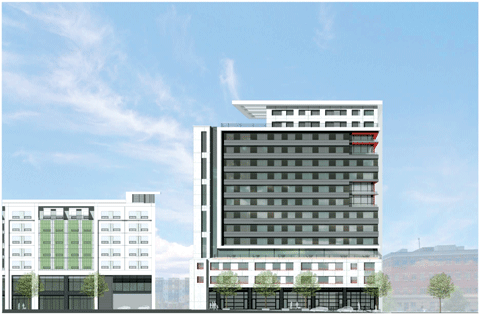“It’s not a church anymore,” Remmel says. He’s right, but that statement alone doesn’t directly suggest any single course of action.
And that’s where MilNeil, a commissioner of the Portland Housing Authority, comes in. First, he observes, “cities change. It’s pretty much the definition of a city.” And second, he posits a clear dichotomy: “If the city doesn’t change architecturally, we’re going to change
demographically.”

BETTER FOR BAYSIDE? A rendering of one of Federated's proposed Midtown towers. |
He’s speaking of the proposed Midtown towers, but the point is just as valid about putting a business in the residential West End: Either we have more and denser housing of all kinds, or the city prices out lower-income residents.
For his part, MilNeil puts social values over aesthetic ones. “I’d much rather preserve our city’s egalitarianism and embrace changes to our skyline,” he says.
Diagnosis #4: Class Conflict
While on the one hand, MilNeil says, “it’s great that we’ve become such a successful city,” with merchants, restaurants, and a vibe that’s attractive to wealthy people; on the other hand he wonders, “Where are we going to put all the rich people who are going to move here?”
And with housing in short supply, and prices on the rise, where will the people the newcomers displace live?
“The rich people are just going to crowd out the working-class and middle-class people,” MilNeil predicts, unless the city undertakes major efforts to “make room for the people who want to live here and need to live here.”
Peter Monro, a landscape architect who is a leader of Keep Portland Livable, the group leading the opposition to Midtown (and suing to block it), says the city has it backwards. Rather than building downtown housing and an industrial park on the outskirts of the city, he says the city should have “good paying jobs at the heart of it,” which will in turn encourage spin-off developments to house those workers and cater to their shopping needs and desires.
His perspective is, he readily admits, that of an urban designer who lives in a historic-landmark home in a historic neighborhood district in the West End. He has a specific vision for how development should occur in Portland, and says the city does too, in its zoning and planning ordinances.
MilNeil, though, says Monro is looking at the wrong problem. Observing Monro’s West End residence and the fact that other plaintiffs in the anti-Midtown suit live in upscale housing too, he is blunt: “They’re homeowners so they’re not really aware of Portland’s housing shortage . . . and they don’t see it in their neighborhoods.”
As a result, he says, their opposition rises from a lack of an appropriate sense of urgency about an issue the city has been working on for more than a decade. “In their privilege they think they have the right to overturn 15 years of neighborhood-planning efforts,” he says.
Now, he says, because of Monro and his allies — and their lawyers — “this whole Bayside Vision is on hold.”
Diagnosis #5: Too many lawyers
Part of the conflict does boil down to lawyers, of course. “If you can hire enough lawyers and kill any project you want,” which makes it harder for all developers, MilNeil says — including the Portland Housing Authority and Avesta, a non-profit developing affordable housing.